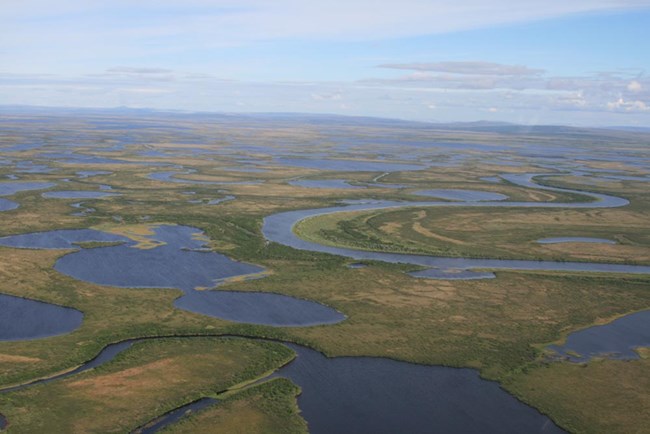Last updated: November 19, 2021
Article
Improving landcover and methane emission estimates from the Arctic and boreal regions

Arctic and boreal regions are an important source of methane, a potent greenhouse gas, to Earth’s atmosphere. Northern wetlands, lakes, and rivers emit large amounts of methane to the atmosphere, which can accelerate climate change. However, scientists have struggled to use field measurements of methane emissions and scale them to the Arctic and boreal regions. One reason for this is the lack of landcover maps that adequately describe wetland, lake, and river area.

In a new study published in Earth System Science Data, researchers conducted an expert assessment to develop a new landcover dataset for the Arctic and boreal regions. A total of 29 experts (including NPS scientist Jon O’Donnell, Arctic Inventory & Monitoring Network) were surveyed to assess landcover across 20 satellite images from different locations across the Arctic and boreal regions. Experts were asked to classify landcover of each image into five wetland types, seven lake types, and three river types. For instance, wetland types could be categorized into permafrost bogs, fens, and other types. Lake types were distinguished based on size (large vs. small) and origin (for example, glacial vs. wetland lakes). Results of the expert assessment were analyzed to provide land area estimates for each wetland, lake, and river type at the circumpolar scale. Each landcover category was also associated with a different methane emission rate. Future research will use this improved landcover dataset to refine methane emission estimates from the Arctic and boreal regions.
The Boreal–Arctic Wetland and Lake Dataset (BAWLD)
Abstract
Methane emissions from boreal and arctic wetlands, lakes, and rivers are expected to increase in response to warming and associated permafrost thaw. However, the lack of appropriate land cover datasets for scaling field-measured methane emissions to circumpolar scales has contributed to a large uncertainty for our understanding of present-day and future methane emissions. Here we present the Boreal–Arctic Wetland and Lake Dataset (BAWLD), a land cover dataset based on an expert assessment, extrapolated using random forest modelling from available spatial datasets of climate, topography, soils, permafrost conditions, vegetation, wetlands, and surface water extents and dynamics. In BAWLD, we estimate the fractional coverage of five wetland, seven lake, and three river classes within 0.5 × 0.5∘ grid cells that cover the northern boreal and tundra biomes (17 % of the global land surface). Land cover classes were defined using criteria that ensured distinct methane emissions among classes, as indicated by a co-developed comprehensive dataset of methane flux observations. In BAWLD, wetlands occupied 3.2 × 106 km2 (14 % of domain) with a 95 % confidence interval between 2.8 and 3.8 × 106 km2. Bog, fen, and permafrost bog were the most abundant wetland classes, covering ∼ 28 % each of the total wetland area, while the highest-methane-emitting marsh and tundra wetland classes occupied 5 % and 12 %, respectively. Lakes, defined to include all lentic open-water ecosystems regardless of size, covered 1.4 × 106 km2 (6 % of domain). Low-methane-emitting large lakes (>10 km2) and glacial lakes jointly represented 78 % of the total lake area, while high-emitting peatland and yedoma lakes covered 18 % and 4 %, respectively. Small (<0.1 km2) glacial, peatland, and yedoma lakes combined covered 17 % of the total lake area but contributed disproportionally to the overall spatial uncertainty in lake area with a 95 % confidence interval between 0.15 and 0.38 × 106 km2. Rivers and streams were estimated to cover 0.12 × 106 km2 (0.5 % of domain), of which 8 % was associated with high-methane-emitting headwaters that drain organic-rich landscapes. Distinct combinations of spatially co-occurring wetland and lake classes were identified across the BAWLD domain, allowing for the mapping of “wetscapes” that have characteristic methane emission magnitudes and sensitivities to climate change at regional scales. With BAWLD, we provide a dataset which avoids double-accounting of wetland, lake, and river extents and which includes confidence intervals for each land cover class. As such, BAWLD will be suitable for many hydrological and biogeochemical modelling and upscaling efforts for the northern boreal and arctic region, in particular those aimed at improving assessments of current and future methane emissions. Data are freely available at https://doi.org/10.18739/A2C824F9X (Olefeldt et al., 2021).
Olefeldt, D., Hovemyr, M., Kuhn, M. A., Bastviken, D., Bohn, T. J., Connolly, J., Crill, P., Euskirchen, E. S., Finkelstein, S. A., Genet, H., Grosse, G., Harris, L. I., Heffernan, L., Helbig, M., Hugelius, G., Hutchins, R., Juutinen, S., Lara, M. J., Malhotra, A., Manies, K., McGuire, A. D., Natali, S. M., O'Donnell, J. A., Parmentier, F.-J. W., Räsänen, A., Schädel, C., Sonnentag, O., Strack, M., Tank, S. E., Treat, C., Varner, R. K., Virtanen, T., Warren, R. K., and Watts, J. D.: The Boreal–Arctic Wetland and Lake Dataset (BAWLD), Earth Syst. Sci. Data, 13, 5127–5149, https://doi.org/10.5194/essd-13-5127-2021, 2021.
